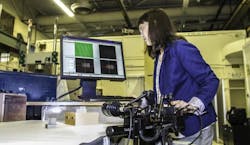New method measures residual stress in parts produced by additive manufacturing
Livermore, CA - Lawrence Livermore National Laboratory (LLNL) researchers have developed an efficient method to measure residual stress in metal parts produced by powder-bed fusion additive manufacturing.
This 3D printing process produces metal parts layer by layer using a high-energy laser beam to fuse metal powder particles. When each layer is complete, the build platform moves downward by the thickness of one layer, and a new powder layer is spread on the previous layer.
While this process is able to produce quality parts and components, residual stress is a major problem during the fabrication process. That's because large temperature changes near the last melt spot—rapid heating and cooling—and the repetition of this process result in localized expansion and contraction, factors that cause residual stress.
Aside from their potential impact on mechanical performance and structural integrity, residual stress may cause distortions during processing resulting in a loss of net shape, detachment from support structures and, potentially, the failure of additively manufactured parts and components.
An LLNL research team, led by engineer Amanda Wu, has developed an accurate residual stress measurement method that combines traditional stress-relieving methods (destructive analysis) with modern technology: digital image correlation (DIC). This process is able to provide fast and accurate measurements of surface-level residual stresses in additively manufactured parts.
The team used DIC to produce a set of quantified residual stress data for additive manufacturing, exploring laser parameters. DIC is a cost-effective, image analysis method in which a dual-camera setup is used to photograph an additively manufacturing part once before it’s removed from the build plate for analysis and once after. The part is imaged, removed, and then re-imaged to measure the external residual stress.
In a part with no residual stresses, the two sections should fit together perfectly and no surface distortion will occur. In additively manufactured parts, residual stresses cause the parts to distort close to the cut interface. The deformation is measured by digitally comparing images of the parts or components before and after removal. A black and white speckle pattern is applied to the additively manufactured parts so that the images can be fed into a software program that produces digital illustrations of high to low distortion areas on the part’s surface.
In order to validate their results from DIC, the team collaborated with Los Alamos National Laboratory (LANL) to perform residual stress tests using a method known as neutron diffraction (ND). This technique, performed by LANL researcher Donald Brown, measures residual stresses deep within a material by detecting the diffraction of an incident neutron beam. The diffracted beam of neutrons enables the detection of changes in atomic lattice spacing due to stress.
Although it’s highly accurate, ND is rarely used to measure residual stress because there are only three federal research labs in the US—LANL being one of them—that have the high-energy neutron source required for this analysis.
The LLNL team’s DIC results were validated by the ND experiments, showing that DIC is a reliable way to measure residual stress in powder-bed fusion additively manufactured parts.
Their findings were the first to provide quantitative data showing internal residual stress distributions in additively manufactured parts as a function of laser power and speed. The team demonstrated that reducing the laser scan vector length instead of using a continuous laser scan regulates temperature changes during processing to reduce residual stress. Furthermore, the results show that rotating the laser scan vector relative to the additively manufactured part’s largest dimension also helps reduce residual stress. The team’s results confirm qualitative data from other researchers that reached the same conclusion.
By using DIC, the team was able to produce reliable quantitative data that will enable additive manufacturing researchers to optimally calibrate process parameters to reduce residual stress during fabrication. Laser settings (power and speed) and scanning parameters (pattern, orientation angle and overlaps) can be adjusted to produce more reliable parts. Furthermore, DIC allowed the Lawrence Livermore team to evaluate the coupled effects of laser power and speed, and to observe a potentially beneficial effect of subsurface layer heating on residual stress development.
LLNL's findings eventually will be used to help qualify properties of metal parts built using the powder-bed fusion additive manufacturing process. The team’s research helps build on other qualification processes designed at LLNL to improve quality and performance of 3D-printed parts and components.
The team's results were reported in the journal Metallurgical and Materials Transactions; for more information, please visit http://dx.doi.org/10.1007/s11661-014-2549-x.
